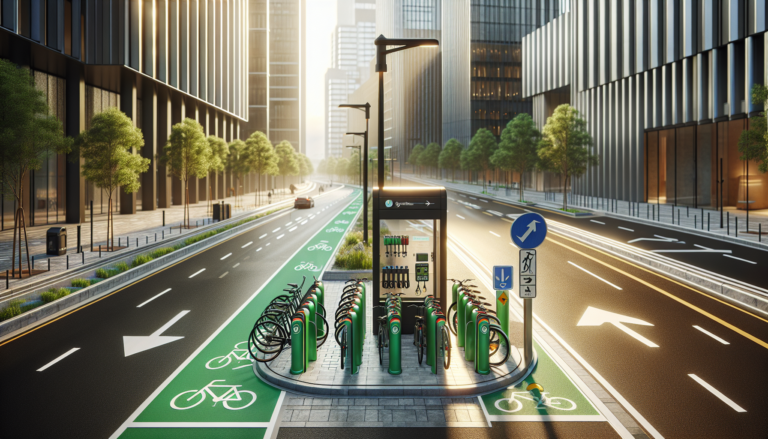Cycling infrastructure plays a vital role in promoting sustainable transportation and creating livable cities. It encompasses the systems, structures, and facilities designed to support safe and efficient bicycle travel. Well-designed cycling infrastructure not only encourages more people to choose cycling as a mode of transportation but also brings numerous benefits to communities, including improved public health, economic development, and environmental sustainability.
This article explores the importance of cycling infrastructure, its historical context, and the key benefits it offers. It also discusses essential design principles and types of bikeways, as well as innovative solutions for intersection management and promoting cycling through infrastructure.
Introduction to Cycling Infrastructure
Definition and Importance
Cycling infrastructure refers to the physical elements and facilities that support safe and convenient bicycle travel. This includes bike lanes, protected bike lanes, off-street paths, bike parking, and other amenities. The presence of well-designed cycling infrastructure is essential for encouraging more people to choose cycling as a mode of transportation, as it provides a sense of safety and comfort for riders of all ages and abilities.
Investing in cycling infrastructure has become increasingly important as cities around the world face challenges related to traffic congestion, air pollution, and public health. By providing dedicated space for cyclists and making it easier and safer to ride, cities can promote a shift towards more sustainable and active transportation options.
Historical Context
The concept of cycling infrastructure is not new. In fact, dedicated bike lanes and paths have been around since the late 19th century, when cycling first became popular as a means of transportation. However, with the rise of the automobile in the 20th century, many cities prioritized car travel and neglected the needs of cyclists.
In recent decades, there has been a resurgence of interest in cycling infrastructure, as cities around the world recognize the many benefits of promoting bicycle travel. Countries like the Netherlands and Denmark have led the way in creating comprehensive networks of bike lanes and paths, and many other cities are now following their example.
Key Benefits of Cycling Infrastructure
Health Benefits
Cycling infrastructure plays a crucial role in promoting public health by encouraging active transportation. Regular physical activity, such as cycling, has been shown to reduce the risk of chronic diseases like obesity, diabetes, and heart disease. By making it easier and safer for people to cycle, cities can promote healthier lifestyles and reduce healthcare costs.
Moreover, cycling infrastructure can help reduce air pollution and improve air quality, which has significant public health benefits. By reducing the number of cars on the road and encouraging more people to cycle, cities can decrease emissions of harmful pollutants like particulate matter and nitrogen oxides.
Economic Benefits
Investing in cycling infrastructure can also have significant economic benefits for cities. Studies have shown that bike lanes and paths can boost local businesses by making it easier for people to access shops and restaurants. In addition, cycling infrastructure projects can create jobs in construction, maintenance, and related industries.
Cycling infrastructure can also help reduce transportation costs for individuals and families. Owning and operating a car can be expensive, whereas cycling is a low-cost option that can save people money on gas, parking, and maintenance. This is particularly important for low-income communities, where transportation costs can be a significant burden.
Environmental Benefits
Cycling is one of the most environmentally friendly modes of transportation, producing zero emissions and requiring minimal resources to build and maintain infrastructure. By promoting cycling through infrastructure investments, cities can reduce their carbon footprint and contribute to climate resilience.
In addition to reducing greenhouse gas emissions, cycling infrastructure can also help mitigate other environmental problems like urban heat islands and stormwater runoff. Green infrastructure elements like trees and bioswales can be integrated into bike lane designs to provide shade, absorb rainwater, and improve the overall urban environment.
Design Principles of Cycling Infrastructure
Safety Improvements
One of the key design principles of cycling infrastructure is ensuring the safety of all road users, particularly vulnerable cyclists. This involves implementing measures to reduce conflicts between cyclists and motor vehicles, such as separating bike lanes with physical barriers, improving intersection designs, and reducing vehicle speeds in shared spaces.
Many cities have adopted Vision Zero policies, which aim to eliminate traffic fatalities and serious injuries through a combination of infrastructure improvements, enforcement, and education. Designing cycling infrastructure with safety as a top priority is essential for achieving these goals and creating a more forgiving roadway environment.
Complete Streets
Another important design principle is the concept of Complete Streets, which aims to create streets that are safe, comfortable, and accessible for all users, regardless of their age, ability, or mode of transportation. This means designing streets that accommodate not only cars but also cyclists, pedestrians, and transit riders.
Complete Streets designs often include elements like wide sidewalks, dedicated bike lanes, transit priority measures, and traffic calming features. By creating streets that are more balanced and multi-modal, cities can promote transportation equity and create more vibrant, livable communities.
Traffic Calming Measures
Traffic calming is another key design principle for cycling infrastructure. This involves using physical measures to reduce vehicle speeds and create a safer, more comfortable environment for cyclists and pedestrians. Examples of traffic calming measures include speed humps, curb extensions, chicanes, and neighborhood traffic circles.
By slowing down vehicle traffic and creating more predictable roadway conditions, traffic calming can help reduce the severity and frequency of crashes involving cyclists. It can also make cycling more appealing by creating a less stressful and more enjoyable riding experience.
Road Diets
Road diets are another important design principle for cycling infrastructure. This involves reallocating space on a roadway to create dedicated bike lanes or other cycling facilities, often by reducing the number or width of vehicle travel lanes. Road diets can be an effective way to improve safety for all road users while also promoting cycling and other active transportation modes.
In addition to creating space for bike lanes, road diets can also help calm traffic, reduce vehicle speeds, and improve pedestrian safety by creating shorter crossing distances and more visible crosswalks. They can also provide an opportunity to add green infrastructure elements like street trees and bioswales.
Types of Bikeways
There are several different types of bikeways that can be used to create cycling infrastructure, each with its own benefits and challenges. The most common types include:
Conventional Bike Lanes
Conventional bike lanes are the most basic type of cycling infrastructure, consisting of a dedicated space for cyclists on the roadway marked with paint and signage. They are typically located adjacent to vehicle travel lanes and provide a clear separation between cyclists and motor vehicles.
While conventional bike lanes can improve safety and comfort for cyclists, they may not provide enough protection on high-speed or high-volume roadways. They are also vulnerable to encroachment by parked cars, delivery vehicles, and other obstacles.
Protected Bike Lanes
Protected bike lanes, also known as cycle tracks, provide a higher level of separation between cyclists and motor vehicles. They are typically located between the sidewalk and the roadway and are separated from vehicle traffic by a physical barrier such as a curb, bollards, or planters.
Protected bike lanes offer a much higher level of safety and comfort for cyclists, particularly on busy urban streets. They can also attract a wider range of users, including children, seniors, and less confident riders. However, they require more space and resources to implement than conventional bike lanes.
Off-Street Bike Paths
Off-street bike paths are completely separate from the roadway and provide a dedicated space for cycling away from motor vehicle traffic. They are often located in parks, along waterways, or on former railroad corridors.
Off-street bike paths offer a high level of safety and comfort for cyclists, as well as a more pleasant and scenic riding experience. They can also provide important transportation connections between neighborhoods, schools, and other destinations. However, they can be expensive to build and maintain, and may not always provide direct access to key destinations.
On some low-volume, low-speed streets, it may be appropriate to create a shared use environment where cyclists and motor vehicles share the same space. This can be achieved through traffic calming measures, signage, and other design elements that encourage slower speeds and greater awareness of cyclists.
Shared use streets can be a cost-effective way to improve cycling conditions in some neighborhoods, particularly where there is not enough space or demand for dedicated bike lanes. However, they may not be appropriate on higher-volume or higher-speed streets, and may not provide enough protection for less confident cyclists.
Innovative Cycling Infrastructure Designs
In addition to the standard types of bikeways, there are also many innovative cycling infrastructure designs that have been implemented around the world to improve safety, comfort, and accessibility for cyclists. Here are a few examples:
Hovenring
The Hovenring is a suspended circular cycle bridge in the Netherlands that allows cyclists to safely cross a busy intersection without interacting with motor vehicle traffic. It is an iconic example of cycling infrastructure that prioritizes the safety and convenience of cyclists over cars.
Berenkuil
The Berenkuil is an elevated traffic circle in the Netherlands that separates cyclists and pedestrians from motor vehicle traffic. It consists of a circular path for cyclists and a wide sidewalk for pedestrians, with vehicles traveling underneath in a tunnel. The design is a great example of a safe and efficient intersection for cyclists and pedestrians.
Intersection Management for Cyclists
Intersections are one of the most challenging and dangerous areas for cyclists, as they are often the site of conflicts with turning vehicles. To improve safety and comfort for cyclists at intersections, there are several design treatments that can be implemented:
Advanced Stop Lines
Advanced stop lines, also known as bike boxes, are designated areas at the front of an intersection that allow cyclists to wait ahead of queuing vehicles during a red light. This improves visibility and safety for cyclists, as they can position themselves in front of vehicles and avoid conflicts with turning traffic.
Bike-Specific Signaling
Bike-specific signaling, such as separate traffic lights for cyclists or leading pedestrian intervals, can also help improve safety and comfort for cyclists at intersections. These signals give cyclists a head start or a separate phase to cross the intersection, reducing conflicts with turning vehicles.
Promoting Cycling Through Infrastructure
While well-designed cycling infrastructure is essential for promoting cycling, it is not the only factor. Cities can also use other strategies to encourage more people to cycle, such as:
Bike Sharing Programs
Bike sharing programs can be a great way to make cycling more accessible and convenient for people who do not own a bike or who only need one for short trips. These programs typically involve a network of bike stations where users can pick up and drop off bikes using a smartphone app or membership card.
Cycling Network Maps
Providing clear and user-friendly cycling network maps can also help encourage more people to cycle by making it easier to navigate the city by bike. These maps should show the location of bike lanes, paths, and other cycling facilities, as well as key destinations and routes.
Conclusion
Cycling infrastructure is an essential component of sustainable and livable cities. By providing safe, comfortable, and convenient spaces for cycling, cities can promote active transportation and reduce their reliance on cars. Well-designed cycling infrastructure brings numerous benefits, including improved public health, economic development, and environmental sustainability.
To create effective cycling infrastructure, cities should follow key design principles such as safety improvements, Complete Streets, traffic calming, and road diets. They should also consider different types of bikeways and innovative designs that can improve safety and comfort for cyclists.
Ultimately, promoting cycling through infrastructure is not just about creating bike lanes and paths. It is about creating a culture of cycling that is accessible, convenient, and enjoyable for people of all ages and abilities. By investing in cycling infrastructure and supporting programs, cities can create more equitable, sustainable, and livable communities for all.






